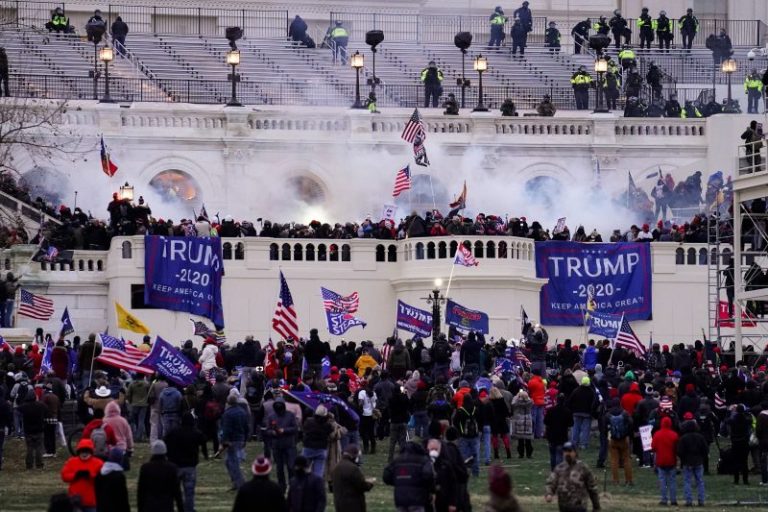A two-year probe of law enforcement actions related to the U.S. Capitol insurrection found missed opportunities, weak risk-mitigation procedures and insufficient guidance to officers before and after the riot.
The “Capitol Attack” investigation by the Government Accountability Office (GAO) revealed repeated lapses in the sharing of information between and sometimes within 10 federal agencies that dealt with the Jan. 6, 2021, attack on the U.S. Capitol by people who tried to overturn Donald Trump’s 2020 presidential election loss. The findings echo previous reporting by The Washington Post and others on these shortfalls.
The probe produced seven reports, with the final one issued last week. It said all the agencies “identified potential threats of violence” and communicated that to law enforcement partners, but not always as widely as needed. In some cases, the agencies “did not fully process information or share it, preventing critical information from reaching key” officials.
Officials at the Department of Homeland Security (DHS), Capitol Police and the U.S. Park Police, for example, “did not consistently share all fully developed threat information,” said the GAO, a congressional watchdog. The Capitol Police did not even share some intelligence with its front-line officers.
Contrary to Monday’s assertion by Fox News commentator Tucker Carlson that the Jan. 6 rioters “were not insurrectionists, they were sightseers,” GAO presented the stark facts of the attack in a letter accompanying the performance audit: “Over the course of about 7 hours, more than 2,000 protesters entered the U.S. Capitol on January 6, disrupting the peaceful transfer of power and threatening the safety of the Vice President and members of Congress. The attack resulted in assaults on at least 174 police officers, including 114 Capitol Police and 60 D.C. Metropolitan Police Department officers. These events led to at least seven deaths and caused more than $2.7 billion in losses, according to the Department of Justice.” So far, about 1,000 people from nearly 50 states have been arrested for crimes related to the insurrection.
Oe the day of the riot, the FBI’s Washington Field Office “was tracking 18 domestic terrorism subjects as potential travelers to the D.C. area,” according to the GAO. But because “FBI personnel did not follow policies for processing some tips,” they did not develop into “reports that could have been shared with partners.” The San Antonio Field Office obtained 45 emails related to counterterrorism threats from Parler, a right-wing social media platform, from Nov. 20, 2020, through Jan. 20, 2021, but “did not develop any related reports on January 6 events as required by policy.”
“If the FBI does not process tips or information according to policy and procedures,” GAO added, “information can get lost or may not be developed into threat products that the FBI can share with partners.”
The DHS Office of Intelligence and Analysis developed threat information about someone “with enough ammo to ‘win a small war’ who planned to attend January 6 events while armed,” GAO said. That intelligence was shared with some agencies, but not the Capitol Police, which is the primary agency guarding the Capitol. DHS officials said the information was not shared because DHS did not view the police force as part of the intelligence community, despite its ability to receive classified intelligence.
What the Capitol Police would have done with that information, however, is questionable. GAO found police officials did not share “relevant threat information … agency-wide, resulting in some officers not having complete information.” A GAO survey said 57 percent of low-ranking officers indicated the guidance they received “was slightly or not at all clear.”
When agencies like the FBI and DHS do not manage tips or threats consistent with their policies, that “tells GAO there is a lack of internal controls over their process,” Triana McNeil, GAO’s homeland security and justice director, said by phone.
Two of the previous GAO “Capitol Attack” reports were not released publicly because of information sensitive to law enforcement. Others found that DHS did not take steps to bolster security at the Capitol due in part to confusing procedures, and that the Capitol Police’s emergency procedures are flawed and its officers need better training for violent demonstrations. A GAO audit also looked at how effectively federal agencies used open-source data to assess the risks of Jan. 6.
While the GAO studies do not say whether better procedures and sharing among and within law enforcement agencies would have prevented or diminished the insurrection violence, a key lawmaker said the findings are alarming.
“While it’s impossible to know if the January 6 Attack could have been prevented with better intelligence sharing policies,” said Rep. Bennie G. Thompson (D-Miss.), chairman of the House select committee investigating the Jan. 6 attack and the top Democrat on the House Homeland Security Committee, in an email. “It is damning that certain intelligence products and threat tips weren’t shared amongst agencies or even within certain agencies.”
GAO made 10 recommendations in its most recent report, related to issues within federal agencies including internal control problems, and the processing and sharing of information. All of the agencies accepted the recommendations. In a letter to GAO included in the report, the FBI commended GAO for its “extensive fact gathering and thorough analysis.”
Now the recommendations must be implemented, which the agencies said they will do.
The agencies “need to develop a control environment,” McNeil said, “to make sure everybody is doing what they’re supposed to do all the time.”

